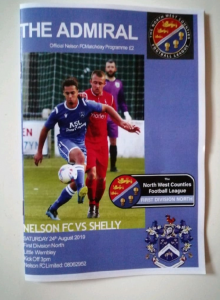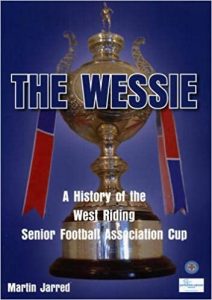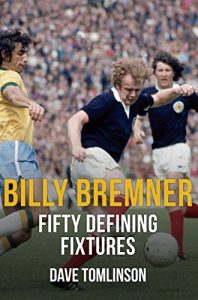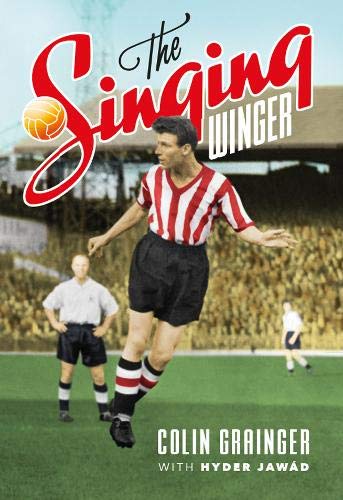2019/20: An Incredible Journey. Match Day 6 – Saturday 24 August 2019: Nelson v Shelley

A trip to Wembley, Little Wembley in fact, also known as Victoria Park, the home of Nelson FC. As you can imagine there is a bit of a dramatic difference between the two Wembley’s, trust me! Capacity wise, whilst the home of the England team in North West London can hold 90,000, the North West England version, holds a mere 2,000.
Here’s a football quiz question for you. Can you think of the club that was the first English side to beat Real Madrid away from home? A side that also won away at Old Trafford in the same season. A side that played in the Football League for ten seasons and has played competitive games against 34 of the current sides in the top four divisions. A side that has played many FA Cup ties in the competition proper with a record home attendance of over 14,000. The answer? Well, all this, and more, has been achieved by ‘The History Boys’ of Nelson FC, also known as ‘The Admirals’.
The origins of Nelson FC can be reputedly traced to a group of townspeople who in 1881, on witnessing a local football match between Burnley and Blackburn, were inspired to form their own team. However, it wasn’t until 1889/90 that they competed in a senior competition.
When football resumed after the First World War, Nelson embarked upon the most remarkable adventure of their history. In 1921 the thirteen non-reserve teams of the Central League were voted into the Football League`s newly formed Third Division North. The first league match, on August 27 1921, brought a record attendance at Seedhill of 9,000.
The next season, 1922/23, saw the Blues lead a close race for much of the season, and five wins in a row during April saw them romp away to the title. On the back of their title triumph, and in preparation for life in Division Two, Nelson took the remarkable step of an overseas tour to Spain, in May 1923. They performed with some success, winning two of their four games, a 2-1 success against Real Oviedo and a 4-2 victory at Real Madrid.
Unfortunately, Nelson`s time in Division Two was to be short-lived, lasting just the one season in which they finished second-bottom of the table. It was clear early on that they were struggling both on and off the pitch, but they achieved some remarkable feats on the way. They had a home victory over Champions-elect Leeds United, one of only nine league defeats for the Yorkshire side and their first away victory came at Manchester United. Few non-league clubs can claim to have won away at both Real Madrid and Manchester United!
A return to Division Three North brought a drop in attendances, though big games saw new records established, such as 13,500 for the visit of table-topping Darlington. That first season back in the third tier of the Football League saw a second-place finish to the North-Eastern side, hence no promotion, and was to be the last time the Blues seriously threatened a return to the national stage.
The next season brought a new and never beaten record attendance at Seedhill of 14,143 for the visit of leaders Bradford Park Avenue. The home team went two goals down but came back to draw 2-2. Two seasons later Nelson became serious strugglers, finding themselves £6,500 in debt. A rock-bottom finish meant a re-election application. They had conceded 136 goals during the season, and all the problems seemed to be down to insufficient gate receipts during difficult times for the area. Re-election was granted in 1928, but three seasons later Nelson were back in the same situation, and 1930/31 was to be their final season as a League club. Nelson struggled on in the Lancashire Combination without winning any honours, and things became much bleaker in 1936. A big loss was incurred that season and the club disbanded on 7 August. The club reformed after the Second World War and entering the Lancashire Combination League, playing in the league until it merged with the Cheshire County League to form the North West Counties League in 1982.

The current Nelson side still ply their trade in North West Counties First Division North and their visitors for this fixture were Shelley from Huddersfield – my connection to Shelley will be revealed later on in the season.
It was a lovely sunny day and barely a breeze, only a hard pitch to contend with. It’s a quaint old ground which has seen better days with a small stand along one side of the pitch. Attendance on the day was nothing like the 14,000 they attracted back in the 1920s. In fact, the crowd was 55 and I was able to count every one of them. Of the game, it was two very evenly matched sides and I was impressed at the standard of football, this being tier 10 of the pyramid. Both defences were much stronger than their own and opposition attack with Ryan Blackburn being outstanding in defence for Shelley, who also showed touches of pace up front with Israel Johnson. Nelson were equally stoic in defence well marshalled by Daniel Fagan. Shelley manager, Ash Berry, was his ebullient self on the touchline in a game that ended as a draw, which on reflection was a fair result but deserved goals.
A final interesting fact about Nelson FC, following their return to act after the war in the Lancashire Combination. They were involved in some terrific tussles for the title with Wigan Athletic over the next few seasons, winning it twice in 1949/50 and 1951/52. In those three seasons of 42 league games apiece, Nelson scored 125, 120 and 139 goals, respectively. The first title season also saw Nelson clinch the Lancashire Combination Cup to seal an historic ‘Double’ in what was at the time one of the premier leagues in the country outside of the Football League. The men at the forefront of this period of success were two young player-managers. Centre-half Bob Johnson moved from Burnley for the start of the 1949/50 season and, when his contract expired, the Blues landed a young man from Manchester City, 30-year-old Joe Fagan. The team built by ‘Uncle Joe’ romped to the title in his first season in 1951/52. Joe left to join Liverpool`s boot room team in 1958 and 25 years later he was the manager who took the Reds to a European Cup, League Championship and League Cup treble.
Saturday 24th August 2019
North West Counties Football League – First Division North
Nelson 0 Shelley 0
Venue: Little Wembley
Attendance: 55
Nelson: Parkinson, C. Lloyd, Grice, Dickinson, Fagan, Wynne, J. Coop, Sharples, Hill, J. Lloyd, Knight.
Substitutes: Close, Townsend, Dewhurst
Shelley: Day, Leech, Andre, Daffern, Blackburn, Keane, O’Keefe, Broadbent, Billington, Pownall, Johnson
Substitutes: White, Robertson, Bradshaw
Steve Blighton
 The FA Cup is recognised as the oldest cup competition in the World with it first being played during 1871/72, when Wanderers beat the Royal Engineers 1-0 at the Oval in London. It predated the first Football League Championship in England by seventeen years, when Preston North End took the title.
The FA Cup is recognised as the oldest cup competition in the World with it first being played during 1871/72, when Wanderers beat the Royal Engineers 1-0 at the Oval in London. It predated the first Football League Championship in England by seventeen years, when Preston North End took the title. This book was originally published in October 1980 (cover right), and at that time the Clough and Taylor partnership was still going strong, with Nottingham Forest having collected a second European Cup triumph following a 1-0 win over a Hamburg side in Madrid containing Kevin Keegan. Within two years Peter Taylor resigned from Forest and took up the management of rivals Derby County from November 1982 to April 1984 and it was during this period that he and Brian Clough fell out, never to reconcile before Taylor’s death in October 1990 of pulmonary fibrosis while on holiday in Mallorca, at the age of just 62. This republishing of With Clough, By Taylor (cover below left) is sold with royalties donated to Action for Pulmonary Fibrosis (
This book was originally published in October 1980 (cover right), and at that time the Clough and Taylor partnership was still going strong, with Nottingham Forest having collected a second European Cup triumph following a 1-0 win over a Hamburg side in Madrid containing Kevin Keegan. Within two years Peter Taylor resigned from Forest and took up the management of rivals Derby County from November 1982 to April 1984 and it was during this period that he and Brian Clough fell out, never to reconcile before Taylor’s death in October 1990 of pulmonary fibrosis while on holiday in Mallorca, at the age of just 62. This republishing of With Clough, By Taylor (cover below left) is sold with royalties donated to Action for Pulmonary Fibrosis ( Given this is a republishing almost forty-years later, the reader has the benefit of all the events post the original release in 1980 and therefore makes it a different read. For instance, back then any reader, given what the pair had achieved up to that point, might have comfortably assumed that there were more years of success to follow, whereas in fact within two years Clough and Taylor were no longer a partnership. And in some ways, it is interesting to see this reflected in the two covers from 1980 and the 2019 publications. The 80s version has the men together deep in concentration, focused on the action in front of them, whereas the latest edition sees them sat before the start of the 1980 European Cup Final, seemingly together but portraying a distance as well. It may simply be that they are nervous ahead of such a major game, or that they are uncomfortable with the intrusive nature of the photographers. However, given that the pair never reconciled after their row surrounding the John Robertson transfer, the current image may well have been chosen to reflect the split.
Given this is a republishing almost forty-years later, the reader has the benefit of all the events post the original release in 1980 and therefore makes it a different read. For instance, back then any reader, given what the pair had achieved up to that point, might have comfortably assumed that there were more years of success to follow, whereas in fact within two years Clough and Taylor were no longer a partnership. And in some ways, it is interesting to see this reflected in the two covers from 1980 and the 2019 publications. The 80s version has the men together deep in concentration, focused on the action in front of them, whereas the latest edition sees them sat before the start of the 1980 European Cup Final, seemingly together but portraying a distance as well. It may simply be that they are nervous ahead of such a major game, or that they are uncomfortable with the intrusive nature of the photographers. However, given that the pair never reconciled after their row surrounding the John Robertson transfer, the current image may well have been chosen to reflect the split.



 In other books within this Amberley series the subject has either been a legendary player or a manager, but in this edition the focus is on Brian Clough who it could be argued is a rarity in having an extraordinary career in both areas of the game.
In other books within this Amberley series the subject has either been a legendary player or a manager, but in this edition the focus is on Brian Clough who it could be argued is a rarity in having an extraordinary career in both areas of the game. The press release with this book declares, “Leeds United: A History…relates the complete and definitive history of the club from foundation to the present day”. It is quite a bold statement from the publisher and is therefore worth scrutiny.
The press release with this book declares, “Leeds United: A History…relates the complete and definitive history of the club from foundation to the present day”. It is quite a bold statement from the publisher and is therefore worth scrutiny. This will be my penultimate Championship Review as this time next month it will be as they say ‘all over’. With a fist full of games remaining the only certainty is Blackpool have been put out of their misery and returned from where they emerged a few years ago after a calamitous season on and off the pitch.
This will be my penultimate Championship Review as this time next month it will be as they say ‘all over’. With a fist full of games remaining the only certainty is Blackpool have been put out of their misery and returned from where they emerged a few years ago after a calamitous season on and off the pitch.